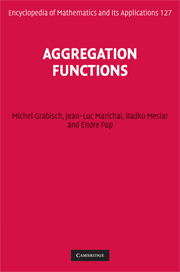Book contents
- Frontmatter
- Contents
- List of figures
- List of tables
- Preface
- 1 Introduction
- 2 Properties for aggregation
- 3 Conjunctive and disjunctive aggregation functions
- 4 Means and averages
- 5 Aggregation functions based on nonadditive integrals
- 6 Construction methods
- 7 Aggregation on specific scale types
- 8 Aggregation on ordinal scales
- 9 Aggregation on bipolar scales
- 10 Behavioral analysis of aggregation functions
- 11 Identification of aggregation functions
- Appendix A Aggregation of infinitely many arguments
- Appendix B Examples and applications
- List of symbols
- References
- Index
5 - Aggregation functions based on nonadditive integrals
Published online by Cambridge University Press: 05 March 2013
- Frontmatter
- Contents
- List of figures
- List of tables
- Preface
- 1 Introduction
- 2 Properties for aggregation
- 3 Conjunctive and disjunctive aggregation functions
- 4 Means and averages
- 5 Aggregation functions based on nonadditive integrals
- 6 Construction methods
- 7 Aggregation on specific scale types
- 8 Aggregation on ordinal scales
- 9 Aggregation on bipolar scales
- 10 Behavioral analysis of aggregation functions
- 11 Identification of aggregation functions
- Appendix A Aggregation of infinitely many arguments
- Appendix B Examples and applications
- List of symbols
- References
- Index
Summary
Introduction
The primitive idea behind integration is the summation of an infinite number of infinitely small quantities, the symbol ∫ being nothing other than the letter “S”, standing for summation. Restricted to a finite universe, integration thus amounts to computing a finite sum, which can be viewed as a particular aggregation function, one of the simplest one can imagine. The reader may wonder then why such a chapter is needed. The above view of integration is in fact the limited perspective offered by the Riemann integral, but if we turn to the viewpoint of Lebesgue, that is, an integration with respect to a measure, the situation becomes much more interesting, and a new realm is offered to us. The main reason is that the notion of measure permits the introduction of “weights” on subsets of the universe. If a classical (additive) measure is used, the Lebesgue integral on a finite universe amounts to computing a weighted sum, but if a nonadditive measure (otherwise called fuzzy measure, or capacity) is used - in this case we speak of the Choquet integral - the result is a nonlinear continuous aggregation function, which is in some sense a concatenation of several different weighted sums.
Other definitions of integration with respect to a measure exist, such as the Sugeno integral where the basic operation is the supremum rather than the sum, or more complex ones, where more general definitions of sums are used, e.g., t-conorms.
- Type
- Chapter
- Information
- Aggregation Functions , pp. 171 - 233Publisher: Cambridge University PressPrint publication year: 2009
- 2
- Cited by



